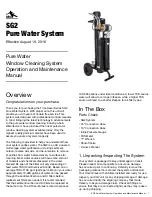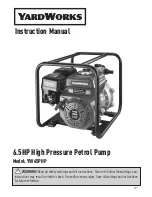
Translation of the Original Operating Instructions
4
4. Scope of delivery
The scope of the delivery of this product includes:
One petrol-driven motor pump, one set of usage instructions, two hose connecting pieces with seals, two hose
clips, one intake strainer, one handle (only LTP 250/25, mounting hints on last page).
Please verify that the scope of delivery is complete. Depending on the purpose of the application, additional
accessories may be necessary (please refer to the chapters titled "Installation",
“Maintenance and
troubleshooting
” and “How to order spare parts“).
If possible, keep the packing until the warranty period has expired. Please dispose of the packing materials in an
environmental-friendly manner.
5. Installation
Depending on the unit being used, the petrol engine pumps from T.I.P. are either equipped with solid metal feet,
or as an alternative they are mounted in a solid steel tube cage with vibration dampeners. These components
must be in place during the operation of the unit since they provide for a secure standing and reduce vibrations.
5.1.
General installation information
During the entire installation process, the unit must not be running.
All connection lines have to be perfectly tight since leaking lines may affect the performance of the pump and
cause considerable damage. Therefore, please use Teflon tape to seal the contact surfaces between the
threaded sections of the lines and the connection with the pump. This use of sealing material such as Teflon tape
is the only way to ensure an airtight assembly.
When tightening threaded connections, please do not apply excessive force which may cause damage.
When laying the connection pipes, you should make sure that the pump is not exposed to any form of weight,
vibration or tension.
5.2.
Installation of the intake line
The inlet of the intake line is to be equipped with a filter for keeping away larger dirt particles
contained in the water which might clog or even damage the pump.
The liquid to be discharged enters the pump through the suction line. Please use a suction line having the same
diameter as that of the suction port of the pump. If the suction height exceeds 4 m, however, it is recommendable
to use a 25% larger diameter - including appropriate reducer elements for the connectors.
The inlet of the intake line is to be equipped with a filter for keeping away larger dirt particles contained in the
water which might clog or even damage the pump.
Moreover, it is highly recommended to install a check valve (non-return valve) which prevents the pressure from
escaping after the pump has cut out and thus protects the pump from damage caused by pressure surges. This
check valve may be installed either directly at the suction port of the pump or at the inlet of the intake line. The
installation at the inlet of the intake line has proven to be beneficial since it facilitates the venting of this intake line
by enabling it to be filled with water.
The check valve with the intake filter - i.e. the entirety of the intake section of the suction port - must be immersed
by at least 0.3 m below the surface of the liquid to be pumped. This will prevent air from being taken in. In
addition, please ensure a sufficient distance of the suction line from both the ground and the sides of water
courses, rivers, ponds etc in order to prevent stones, plants etc from being sucked in.
5.3.
Installation of the pressure line
The pressure line conveys the liquids to be discharged from the pump to the point of withdrawal. To avoid
dynamic flow losses, one should use a pressure line having at least the same diameter as the pressure port of the
pump.
5.4.
Stationary installation
For stationary installation, please fasten the pump on a suitable, solid surface. To reduce vibration, it is
recommended to apply an anti-vibration material - for instance a rubble layer - between the pump and the
installation surface.
The permissible pressure at the intake connection is -1 bar (-0.1 MPa) and at the pressure connection 3 bar (0.3 MPa).
15
Summary of Contents for LTP 500/30
Page 77: ...2 8 9 10 11 12 13 1 4 1 2 3 4 8 75...
Page 79: ...4 LTP 250 25 LTP 500 30 4 5 T I P 5 1 5 2 4 25 0 3 5 3 77...
Page 80: ...5 5 4 LTP 250 25 LTP 500 30 1 bar 0 1 MPa 3 bar 0 3 MPa 6 6 1 6 2 T I P 6 3 15W 30 78...
Page 81: ...6 5 ON 6 4 6 5 ON 6 6 79...
Page 82: ...7 20 10 6 7 OFF 6 8 7 80...
Page 84: ...9 7 5 a a 7 6 7 7 OFF 2 7 8 82...
Page 86: ...11 1 2 3 9 www tip pumpen de 10 PDF service tip pumpen de 11 84...
Page 110: ...Notizen notes note notas...
Page 111: ...Notizen notes note notas...
















































